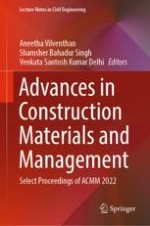This book presents the select papers from the proceedings of the National Conference on Advanced Construction Materials and Management (ACMM 2022). The book discusses the ongoing research and advanced practices in building materials and construction project management. Various topics covered in the book include new/alternate/supplementary construction materials, deterioration mechanisms in construction materials, microstructure characteristics of concrete, special and recycled aggregate concretes, advanced construction techniques, contracts and arbitration, building information modeling (BIM), prefabricated and modular construction, augmented reality (AR) and virtual reality (VR) in construction management, and artificial intelligence and machine learning in construction. The book is a useful reference for researchers and professionals working in the fields of construction materials and management.
